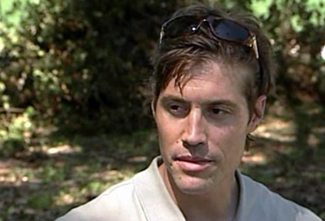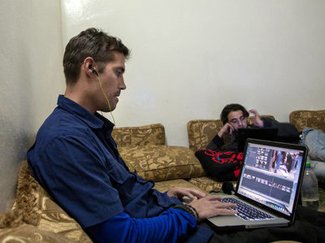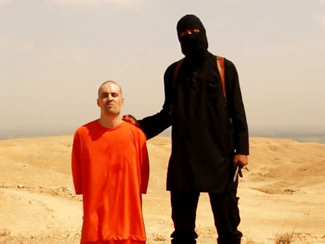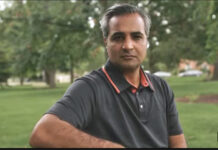By Mark Ellis

People worldwide were shocked and horrified last August when journalist James Foley was beheaded by a British-accented ISIS executioner as Foley kneeled resolutely against a barren backdrop of Syrian hills. What is less known is that Foley – along with many other Western hostages – converted to Islam during their captivity, which apparently meant little to their merciless captors.
The behind-the-scenes story of his ordeal was documented by The New York Times through interviews with five former hostages, local witnesses, relatives and associates of the captives, and a group of advisers who made trips to the Middle East to attempt to free them.
Some details were provided to The Times by a former member of ISIS who was originally housed in the prison where Foley was kept, and who provided additional details about his confinement.
At least 23 foreign hostages from 12 countries have been kidnapped by Syrian insurgents, sold or handed over to ISIS, and held underground in a prison somewhere in proximity to the Syrian city of Raqqa.

Foley was an American freelance journalist filing for GlobalPost and Agence France-Presse. He and his fellow hostages were often beaten and subjected to waterboarding, according to The Times. For months, they were starved and threatened with execution by one group of fighters, then transferred to another terrorist group that gave them improved treatment and even considered freeing them.
The prisoners played games to pass the time, but as conditions got worse they turned on each other.
Foley converted to Islam soon after his capture and adopted the name Abu Hamza, according to The Times. His conversion was confirmed by three other recently released hostages, as well as by his former employer.
“I recited the Quran with him,” Jejoen Bontinck,19, of Belgium, told The Times. Bontinck spent three weeks in a cell with Foley. “Most people would say, ‘Let’s convert so that we can get better treatment.’ But in his case, I think it was sincere.”
Bontinck saw scars on Foley’s ankles and asked about them. Foley told him they “tied his feet to a bar and then hung the bar so that he was upside down from the ceiling. Then they left him there.”
Former hostages said that a majority of the Western prisoners converted to Islam during their captivity. Peter Kassig, 25, an emergency medical technician from Indianapolis, adopted the name Abdul-Rahman, according to his family, who learned about his conversion in a letter smuggled from the prison.
Only a few of the hostages remained true to their faiths, including freelance journalist Steven Sotloff, 30, who is a practicing Jew. On Yom Kippur, he told his guards he was ill and refused to eat so he could observe the traditional fast, a witness told The Times.
Christians throughout history have been martyred for their faith, refusing to deny their Lord, even in the face of horrible punishments, based on the teaching of Jesus:
“But whoever denies me before men, I also will deny before my Father who is in heaven.” (Matthew 10:33)
Those recently released said many of the foreigners converted under duress, but Islam intrigued Foley. When the guards brought an English version of the Quran, those who merely pretended to be Muslims leafed through it quickly, one former hostage said. By contrast, Foley spent hours studying the text.
His first set of guards, from the Nusra Front, viewed his conversion to Islam with distrust. But the second group that held him seemed to think it was sincere. For an extended period, Foley’s abuse stopped. Unlike the Syrian prisoners, who were chained to radiators, Foley was allowed to move freely inside his cell.
When Bontinck was released, he jotted down the phone number for Foley’s parents and promised he would call them. They said they hoped to meet again. He left thinking that Foley would be released.
During the course of interrogations, jihadists found images of American military on Foley’s laptop, taken during his assignments in Afghanistan and Iraq, according to The Times.
“In the archive of photographs he had personally taken, there were images glorifying the American crusaders,” an ISIS fighter wrote in an article published after Foley’s death.
Late last year, the jihadists brought the prisoners to a cell underneath the Children’s Hospital in Aleppo. By January 2014, there were at least 19 men in one cell measuring about 215 square feet and four women in an adjoining one. All but one of them were European or North American. The relative freedom that Foley enjoyed came to an end. Each prisoner was handcuffed to another prisoner.
The French-speaking guards were replaced by English-speaking ones, nicknamed the Beatles. Foley recognized them with alarm as ones who were involved with the worst of his torture earlier.
The jihadists, relatively unknown by the world only a few months earlier, had begun to call themselves Islamic State.
After months of holding the prisoners without making any demands, the jihadists suddenly crafted a plan to ransom them. By December 2013, the militants had exchanged several emails with Foley’s family, as well as with the families of other hostages, according to The Times.
As the weeks passed, Foley noticed that his European cellmates were invited outside multiple times to answer questions, but none of the American or British prisoners were invited.
They soon realized the kidnappers had identified the nations that were most likely to pay ransoms, a former hostage told The Times.
The European prisoners were forced to make videos that eventually included death threats and execution deadlines in an effort to force their nations to pay.
One day, their captors arrived with orange jumpsuits and made a video with the French hostages in the jumpsuits, in an attempt at a crude parody of those worn by prisoners at Guantánamo Bay.
They also began waterboarding a few hostages, as C.I.A. interrogators had treated Muslim prisoners at “black sites” during the George W. Bush administration, according to The Times.
Then the 23 prisoners were put into two groups. The American and British hostages received the most abuse, because of the Islamists’ accusations against their countries and because their governments would not negotiate, according to The Times.
The one who suffered the worst treatment was Foley. In addition to prolonged beatings, he also endured mock executions and waterboarding.
His food rations were cut to the bone; he received roughly a small cup of food per day for an extended period.
The hostages spent weeks in darkness. In one basement, their only illumination was a sliver of light that stretched under their locked door. After nightfall, they couldn’t see the meager portion of food they received.
Sadly, the prisoners turned on one each other, with fights breaking out.
As winter cold set in, Foley shared his small portion of food and his only blanket with another prisoner, according to The Times.
In the spring of 2014, the hostages were moved from beneath the hospital in Aleppo to Raqqa, the locus of ISIS’s self-declared caliphate. The prisoners were kept in a building near an oil facility.
In late May, an Italian, Federico Motka, was told he could go, according to a fellow captive, allegedly after Italy paid a ransom. (The Italian government denied the claim.) But his co-worker, David Haines was beheaded in September after he was forced to read a script that blamed the British government.
Several Spanish prisoners were released after the Spanish government paid their ransom.
Fifteen hostages were freed from March to June for ransoms averaging more than two million euros, according to The Times report.
Among the last to go was a Danish photojournalist, Daniel Rye Ottosen, 25, released in June after his family paid a multimillion-euro ransom.
Foley seemed to sense the end was near. In his last letter to his family, amid expressions of love, he instructed

them about how to distribute the remaining money in his bank account.
In August, militants took him to a barren hillside outside Raqqa. They made him kneel. He looked straight into the video camera, his expression unwavering, while a British-accented executioner stood behind, with menacing eyes piercing through two slits on his black hood. Then the man slit Foley’s throat and severed his head from his body. May God rest his soul.
The original New York Times story is here




absolute nonsense .He was praying rosary even just before his execution. shame on U
Comments are closed.